
Prunus maritima, the beach plum, is a species of plum native to the East Coast of the United States. It is a choice wild edible and its few pests and salt tolerance make it a resilient fruit crop for degraded lands and urban soils.
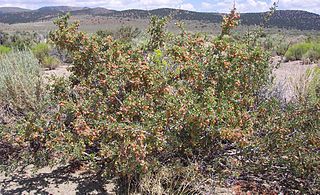
Prunus andersonii is a species of shrub in the rose family, part of the same genus as the peach, cherry, and almond. Its common names include desert peach and desert almond. It is native to eastern California and western Nevada, where it grows in forests and scrub in desert and mountains. It was named after Charles Lewis Anderson by Asa Gray.

The Lake Wales Ridge National Wildlife Refuge is part of the United States National Wildlife Refuge (NWR) System, located in four separated areas on the Lake Wales Ridge east of US 27 between Davenport and Sebring Florida. The 1,194 acre (4.8 km2) refuge was established in 1990, to protect a host of plants and animals. It is also the first to be designated primarily for the preservation of endangered plants, and is not open to the general public. It contains a high proportion of remaining Florida scrub habitat. It is administered as part of the Merritt Island National Wildlife Refuge.
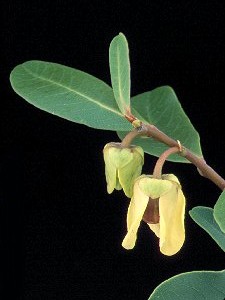
Asimina tetramera, commonly known as the four-petal pawpaw, is a rare species of small tree or perennial shrub endemic to Martin and Palm Beach Counties in the state of Florida. The species is currently listed as endangered under the Endangered Species Act and as endangered by the International Union for Conservation. The four-petal pawpaw is part of the Annonaceae family alongside other Asimina species.
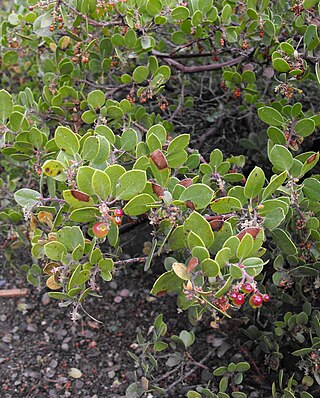
Arctostaphylos rudis, with the common names Shagbark manzanita and Sand mesa manzanita, is a species of manzanita.
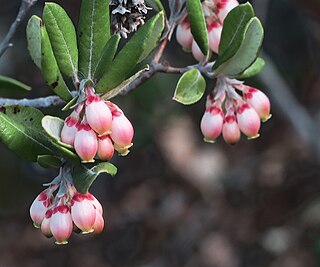
Xylococcus is a monotypic genus of flowering plants in the heather family which contains the single species Xylococcus bicolor, commonly known as the mission manzanita. It is a burl-forming, evergreen shrub with leathery leaves and smooth dark reddish bark. From December to February, white to pink urn-shaped flowers adorn the foliage, often attracting hummingbird pollinators. It is native to southern California and the Baja California Peninsula, south to the Sierra de la Giganta. There is growing concern over the future of this plant, referred to as the "queen of the elfin forest, " as it may possibly lose up to 88% of its habitat and its wild seedlings are failing to survive more than a full year.

Warea carteri is a species of plant in the mustard family, Brassicaceae, known by the common names Carter's pinelandcress and Carter's mustard. It is an endangered, fire-dependent annual herb occurring in xeric, shrub-dominated habitats on the Lake Wales Ridge of central Florida in the United States.

Rhamnus ilicifolia is a species of flowering plant in the buckthorn family known by the common name hollyleaf redberry. It is native to western North America, where it is a common plant growing in many types of habitat, including chaparral and wooded areas, from Oregon through California, to Baja California and Arizona.
Prunus eremophila, also known by its common name Mojave Desert plum, is a rare species of plum native to California.

Bonamia grandiflora is a rare species of flowering plant in the morning glory family known by the common names Florida lady's nightcap, Florida bonamia, and scrub morning glory. It is endemic to Central Florida, where there are about 100 known populations remaining, many of which are within the bounds of the Ocala National Forest. The plant has declined in recent decades primarily due to the development of its habitat, which is being converted to urban zones and citrus groves. This is the primary reason that the plant was federally listed as a threatened species in 1987.

Chionanthus pygmaeus is a rare species of flowering plant in the olive family known by the common name pygmy fringetree. It is endemic to Florida, where there are 46 known occurrences as of 2010. The plant is found in increasingly rare habitat in Central Florida that is being consumed for development, and some protected areas are not managed adequately. Most populations are small. It is a federally listed endangered species of the United States.

Chrysopsis floridana is a rare species of flowering plant in the family Asteraceae, known by its common name, Florida golden aster. It is endemic to Florida in the United States, where it is known from Hillsborough, Hardee, Manatee, and Pinellas Counties. It is considered an endemic of the west-central coast of the state in the general vicinity of Tampa Bay. There are 17 to 20 occurrences, many of which have few individuals, but one of which has over one million plants. In 1986 the plant was added to the US endangered species list because it was becoming increasingly rare, it was growing only on private property, and its habitat was unprotected and being destroyed and degraded by a number of forces. It is found at Bell Creek Nature Preserve in Riverview, Florida.

Clitoria fragrans is a rare species of flowering plant in the legume family known by the common name pigeon wings, or sweet-scented pigeon wings. It is endemic to Central Florida, where it was known most recently from 62 occurrences, but no current estimates of the total global population are available. The plant is a federally listed threatened species of the United States.

Conradina brevifolia is a rare species of shrub in the mint family known by the common name short-leaved false rosemary. It is endemic to Central Florida, where it is known only from the Lake Wales Ridge. There are perhaps 36 occurrences of the plant remaining, and 10 of these are likely to be destroyed as their habitat is fragmented in the coming years. About 15% of the Lake Wales Ridge, the only home territory of the plant, remains today, the rest having been cleared for development and citrus groves. Few of the extant populations have more than 25 plants. This is a federally listed endangered species of the United States.
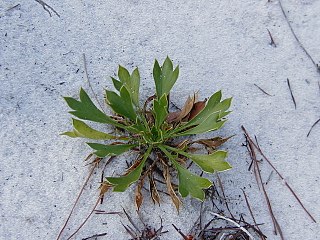
Eryngium cuneifolium is a rare species of flowering plant in the carrot family known by the common names wedgeleaf eryngo, wedge-leaved button-snakeroot, and simply snakeroot. It is endemic to the state of Florida in the United States where it is known only from Highlands County. It is one of many rare species that can be found only on the Lake Wales Ridge, an area of high endemism. It was federally listed as an endangered species of the United States in 1987.

Hypericum cumulicola is a rare species of flowering plant in the family Hypericaceae known by the common name highlands scrub hypericum, or highlands scrub St. John's wort. It is endemic to Florida, where it is threatened by habitat loss and degradation. It is a federally listed endangered species of the United States.

Prunus angustifolia, known commonly as Chickasaw plum, Cherokee plum, Florida sand plum, sandhill plum, or sand plum, is a North American species of plum-bearing tree. It was originally cultivated by Native Americans before the arrival of Europeans. The species' name angustifolia refers to its narrow leaves. It became the official state fruit of Kansas in 2022.
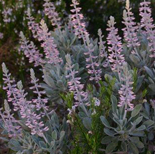
Lupinus aridorum is a rare species of lupine known by the common name scrub lupine. It is endemic to Florida in the United States, where there were 10 known populations remaining in 2003. Fewer than 6000 individual plants were counted. It is threatened by the loss and degradation of its habitat. The scrub lupine is a federally listed endangered species of the United States.

Polygala lewtonii is a rare species of flowering plant in the milkwort family known by the common name Lewton's polygala, or Lewton's milkwort. It is endemic to Florida in the United States, where it is limited to the central ridge of the peninsula. There are about 49 occurrences of the plant remaining. Most occurrences contain very few plants. The species is threatened by the loss and degradation of its habitat. This is a federally listed endangered species of the United States.
The Florida peninsula inland scrub is a shrubland community found on the Florida peninsula. The largest remaining blocks of inland scrub are in and around the Ocala National Forest and in the Lake Wales Ridge National Wildlife Refuge. The Archbold Biological Station near Lake Placid contains about 20 km2 (7.7 sq mi) of scrub habitat and sponsors biological research on it. The scrub occurs on a series of north-south running ridges composed of sand derived from ancient dune fields. The soil, a type of entisol, is derived from quartz and is low in organic matter, silt, and clay. Because the low-nutrient sandy soils do not retain moisture, the ecosystem is effectively an arid one.



















